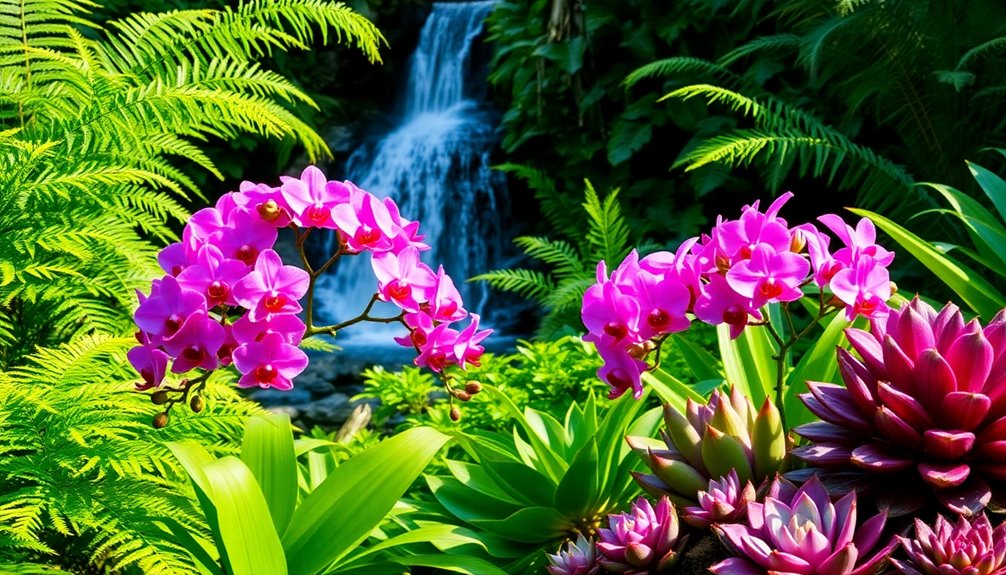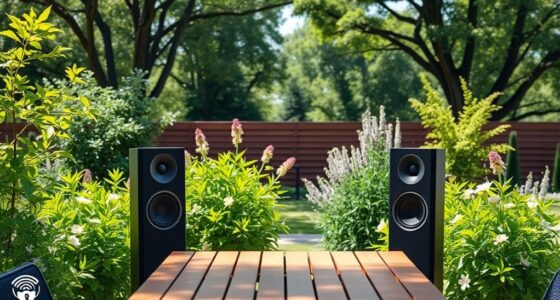If you want to transform your garden, consider these 10 gorgeous plants. Climbing roses and vibrant hibiscus add stunning colors and scents. Jasminum sambac offers lovely white blooms year-round, while croton brings in vibrant foliage. Bougainvilleas thrive in sunny spots, adding a tropical flair. Sunshine ligustrum and golden mop cypress provide lush greenery, and the pugster amethyst butterfly bush attracts pollinators with its fragrant flowers. Finally, the autumn ember azalea showcases bright blooms and stunning fall foliage. With these choices, your garden will burst with life and beauty. Stick around to discover more unique plant options!
Key Takeaways
- Roses offer a range of varieties, from climbing to miniature, adding vibrant colors and beautiful fragrances to any garden space.
- Hibiscus provides stunning bell-shaped flowers and can serve as attractive shrubs or small trees, thriving in full sun with proper care.
- Bougainvilleas create dramatic displays with their vibrant, drought-resistant blooms and can be trained to cover fences or trellises.
- Butterfly Bush attracts pollinators with its fragrant, amethyst-toned flowers, enhancing garden biodiversity while providing stunning visual interest.
- Autumn Ember Azalea features striking orange-red blooms and attractive fall foliage, perfect for continuous blooming and compact garden spaces.
Roses
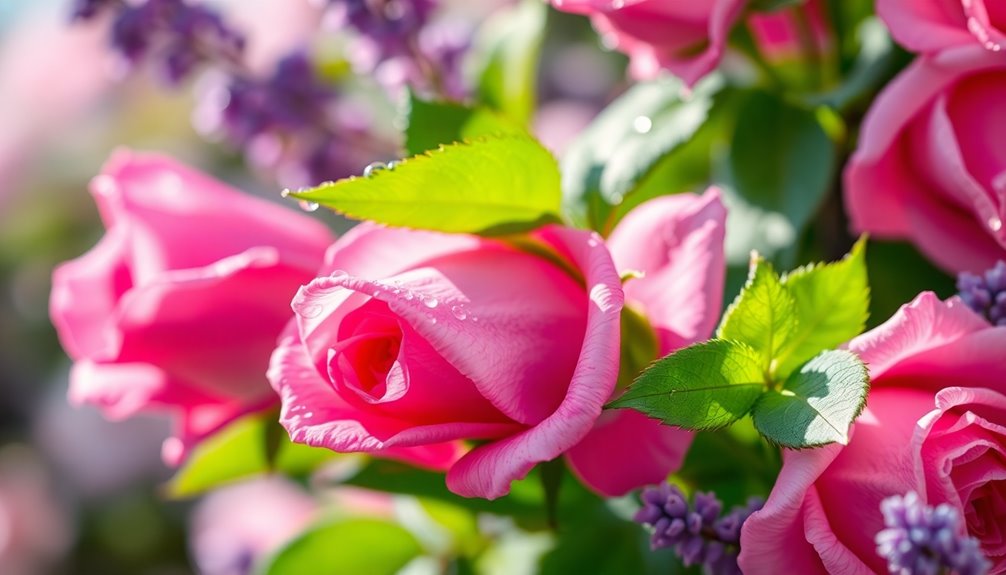
Roses are the crown jewels of any garden, bringing elegance and charm to your outdoor space. You can choose from various rose varieties, each adding its unique flair.
Climbing roses are fantastic for vertical growth, while floribundas offer vibrant clusters perfect for mixed borders. If you have a smaller garden, opt for miniature roses, which pack a punch in color without overwhelming the space.
To enhance your design, consider planting roses in different heights alongside shrubs and trees, creating a visually rich landscape. Incorporating companion plants can further enhance the overall health and beauty of your rose garden.
Don't forget to include seating areas in your backyard rose garden, inviting you to savor the beauty. With proper care, your roses will thrive and transform your garden into a stunning retreat.
Hibiscus
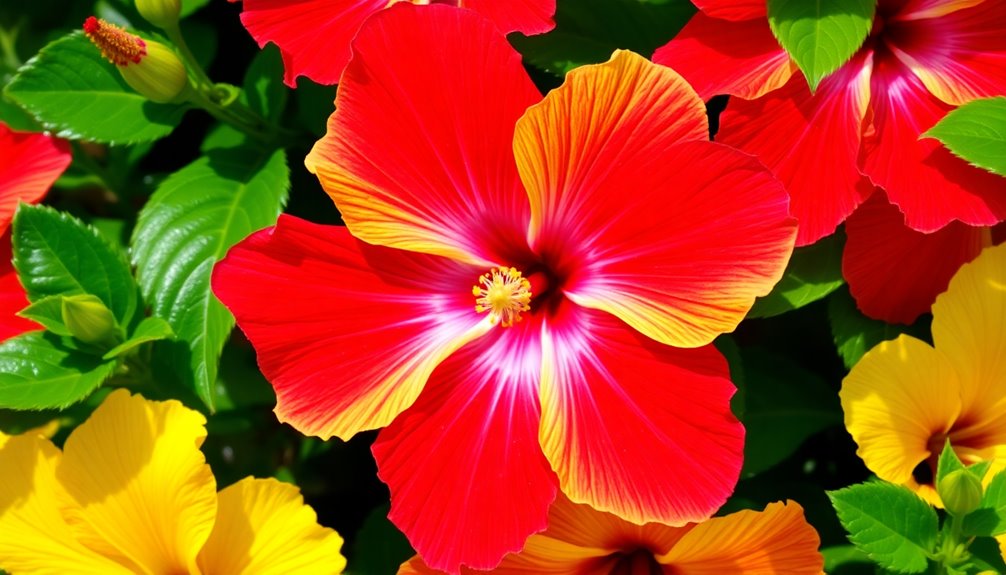
After enjoying the elegance of roses, you'll find hibiscus brings its own vibrant charm to your garden.
These stunning plants feature bell-shaped flowers with five or more petals, available in colors like red, orange, yellow, and purple. Depending on the variety, hibiscus can reach heights of 5 to 15 feet, making them versatile as shrubs or small trees. Over 200 species of hibiscus have been identified, showcasing a rich diversity that enhances any garden.
The glossy, alternately borne leaves can be lobed or toothed, adding texture to your landscape. Hibiscus thrives in full sun and moist, well-drained soil, so ensure you provide proper care and fertilization.
Keep an eye out for pests and diseases, as they can be susceptible. With proper maintenance, hibiscus will reward you with beautiful blooms throughout the growing season.
Jasminum Sambac
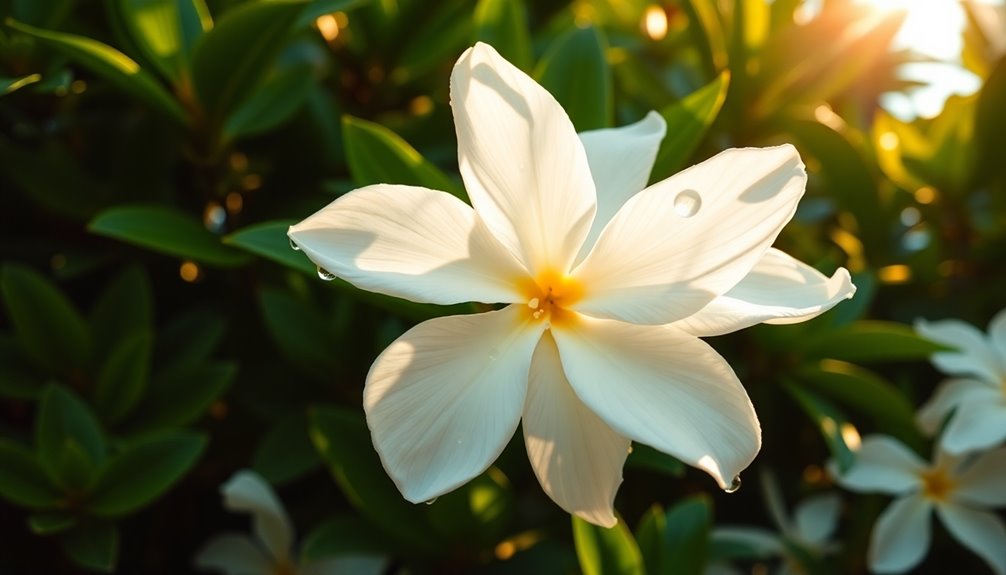
If you're looking for a plant that combines beauty and fragrance, Jasminum sambac is an excellent choice for your garden.
This evergreen vine or shrub reaches heights between 0.5 to 3 meters and showcases lovely white flowers that bloom year-round in clusters. With its ovate leaves and sweet aroma, it's sure to be a highlight in your landscape.
Jasminum sambac thrives in full to partial sun and prefers enriched, well-drained soil. Regular watering is essential, especially during hot months, and monthly fertilization supports lush growth. Additionally, it is recognized for its high-quality jasmine flower-oil used in the perfume industry.
It's also versatile; you can propagate it through cuttings or layering. Whether in a pot or as part of a garden bed, this plant adds a touch of elegance and charm.
Croton

Croton plants are a stunning addition to any garden, known for their vibrant foliage and diverse color patterns. Native to India and Malaysia, these perennial evergreens can grow up to 10 feet tall, though dwarf varieties are available too. Their leaves come in a wide array of shapes and colors, including reds, oranges, and yellows, clustering together for maximum visual impact. To care for your croton, place it in bright, indirect light and keep the soil moist but not soggy. Full and bushy appearance adds to their appeal, making them ideal for creating a striking focal point in your landscape. Fertilize every two weeks during spring and summer for optimal growth. Prune back leggy plants at the beginning of the growing season to encourage bushier growth. With the right conditions, your croton will thrive and bring a splash of color to your garden!
Bougainvilleas
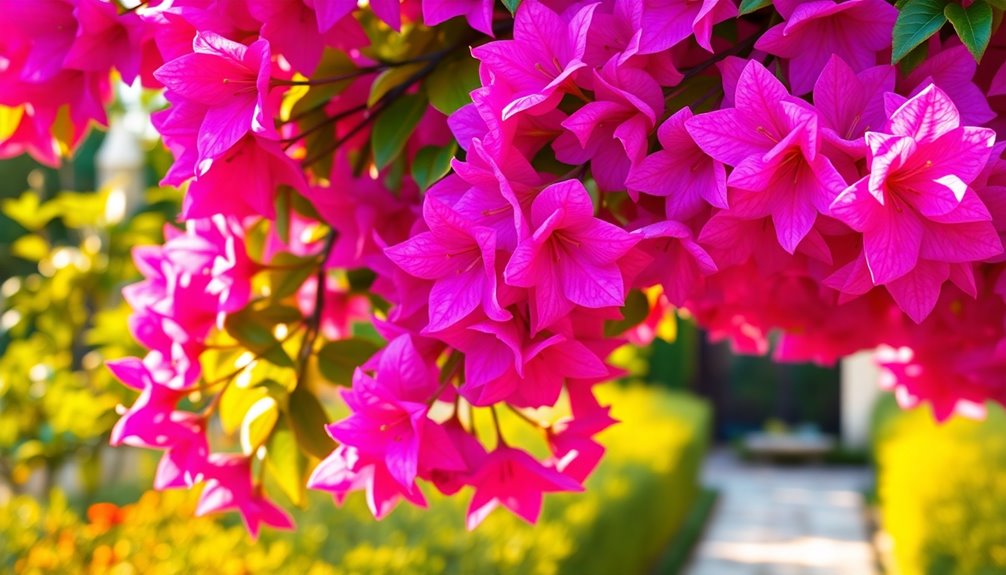
Bougainvilleas are a vibrant choice for your garden, offering a breathtaking display of color and texture.
These woody vines can reach heights of 15 to 40 feet, showcasing heart-shaped leaves and striking bracts in shades of pink, purple, red, and more. They thrive in full sun and require sandy or loamy soils with good drainage. Additionally, they are resistant to drought and can tolerate heat and salt.
Water them a couple of times a week, allowing the soil to dry between waterings. Regularly prune to maintain their shape and encourage blooming on new growth.
Bougainvilleas are perfect for coastal gardens, containers, or vertical spaces, and they attract pollinators with their colorful blooms.
Plus, they're generally pest-free and disease-resistant—making them a low-maintenance choice for any garden enthusiast.
Cypress Golden
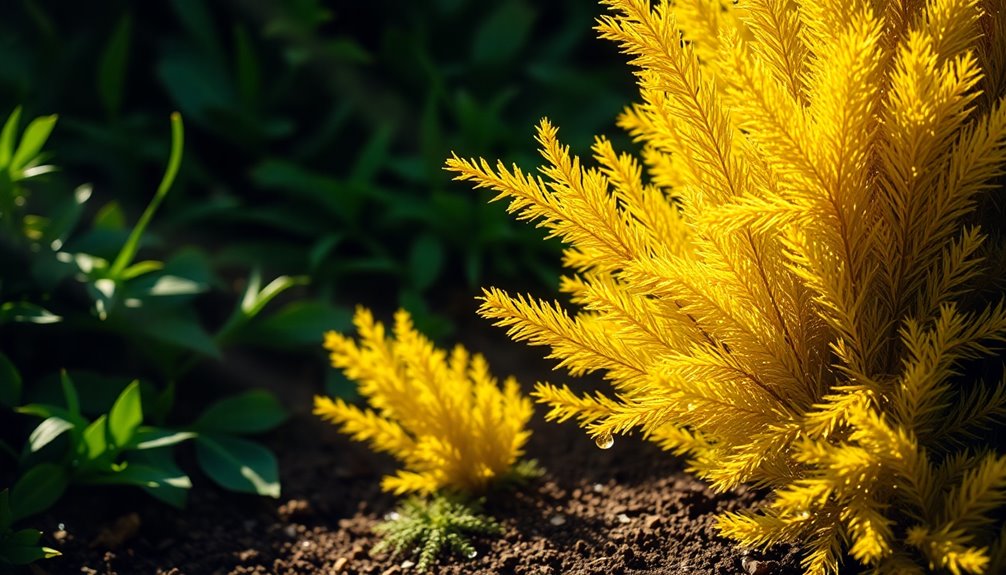
Cypress Golden adds a splash of vibrant color to your garden with its stunning golden-yellow foliage.
This dwarf evergreen tree features a broadly conical form, reaching heights of 10 to 15 feet and widths of 4 to 5 feet. Its spreading branches display pendant sprays of scale-like leaves, creating a two-toned effect with bright yellow and green tips.
Ideal for full sun or partial shade, it thrives in acidic, well-drained, moist loam soil. With a slow to moderate growth rate, this tree requires deep watering weekly, unless it rains. Additionally, it shows tolerance to occasional flooding, making it a resilient choice for various garden settings.
It's deer-resistant and attracts songbirds, making it an excellent choice for hedges, screens, or as a specimen tree, adding winter interest to your landscape.
Sunshine Ligustrum
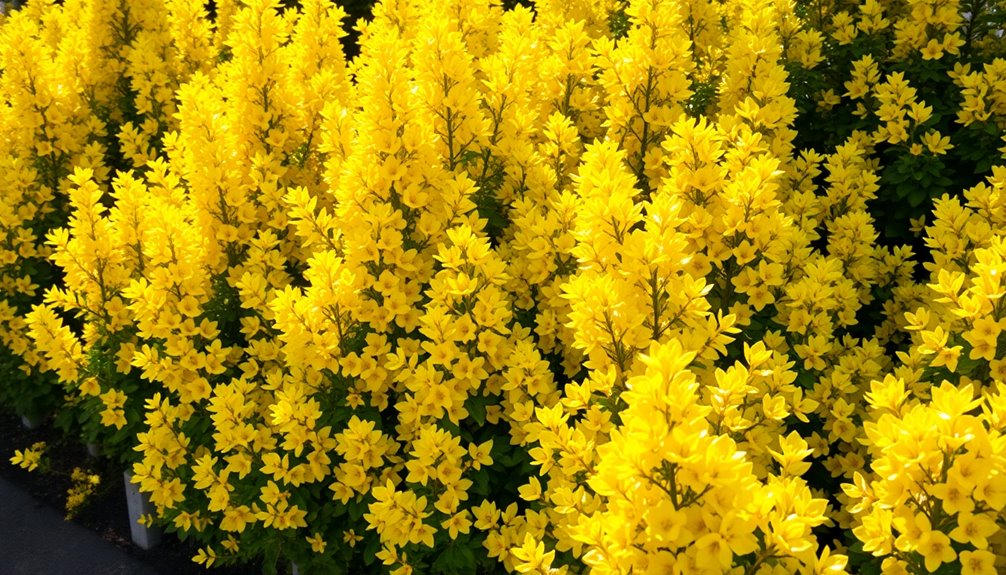
Following the vibrant hues of the Cypress Golden, the Sunshine Ligustrum brings its own dazzling flair to your garden.
With its striking golden-yellow, glossy foliage, this plant stands out year-round. Its compact, upright growth habit typically reaches 3 to 5 feet, forming a dense, rounded shape that's perfect for hedges or borders. Mature height ranges from 3 to 5 feet makes it suitable for various garden settings.
Thriving in full sun to partial shade, it prefers well-draining soil and requires regular watering, especially when establishing. Once settled, it becomes more drought-tolerant.
You'll appreciate its low-maintenance nature—light trimming once or twice a year keeps it looking sharp.
Pair it with dark green evergreens or flowering perennials for an eye-catching contrast that enhances your landscape's beauty.
Golden Mop Cypress
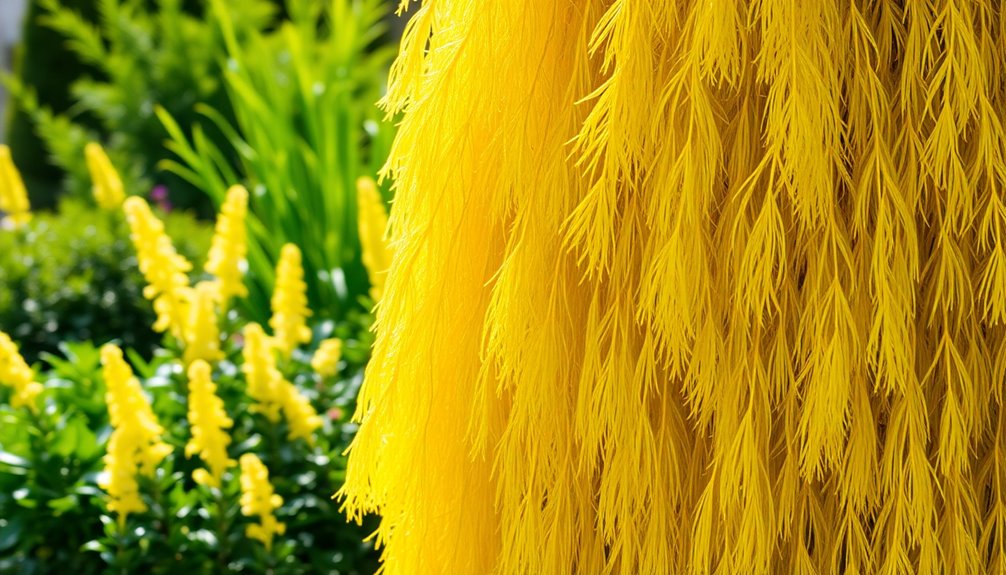
One stunning addition to your garden is the Golden Mop Cypress, a unique conifer that catches the eye with its golden yellow-green foliage.
Reaching about 5 feet tall and 3-4 feet wide, its mounded, weeping form adds elegance to any landscape. This slow-growing plant thrives in well-drained, moist soil and prefers full sun to part shade, though part shade is ideal. The Golden Mop Cypress is suitable for growing zones 3-9, making it adaptable to a variety of climates.
Water it frequently during establishment, then once a week. It's deer-resistant and drought-tolerant, making it a practical choice.
Whether you use it as a specimen plant, in rock gardens, or as part of a border, the Golden Mop Cypress will surely enhance your garden's beauty.
Just remember to provide wind protection and mulch to retain moisture.
Pugster Amethyst Butterfly Bush
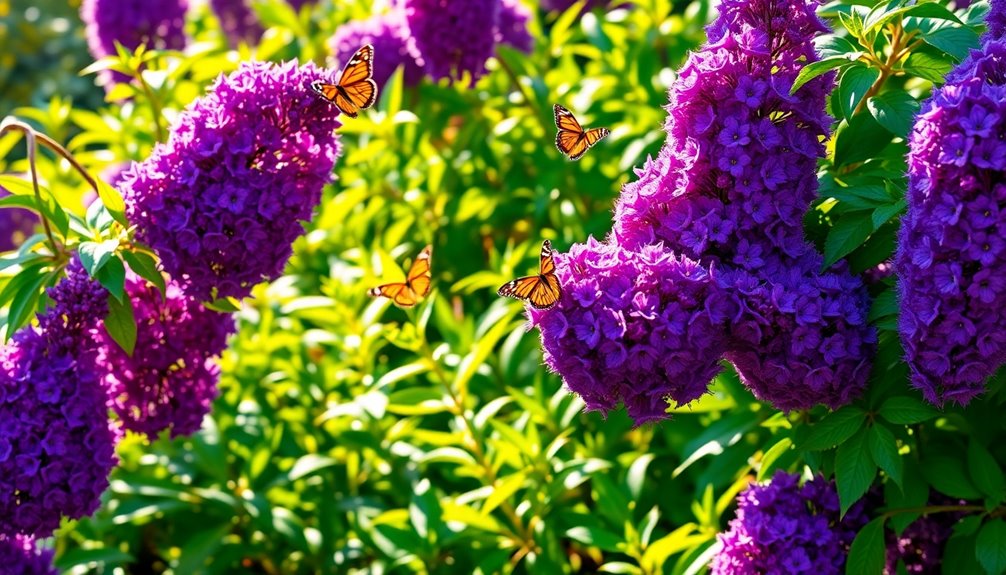
If you're looking to attract pollinators to your garden, the Pugster Amethyst Butterfly Bush is a fantastic choice. This compact shrub reaches 24 inches tall and wide, showcasing stunning amethyst-toned flowers with a tiny yellow-orange eye.
Its fragrant blooms not only please the senses but also draw in butterflies and bees. Plant it in full sun to part shade, in average, well-drained soil with a slightly acidic to neutral pH. Regular watering during its first growing season helps establish roots, and it becomes drought-tolerant once settled. Additionally, remember that this butterfly bush is considered invasive in many regions, so check local regulations before planting. The plant's ability to thrive in various conditions highlights the importance of environmental interactions in its development.
Prune in early spring to encourage blooming and remove any winter damage. Pair it with yellow Stella De Oro Lillies for a vibrant garden display that's sure to impress!
Autumn Ember Azalea
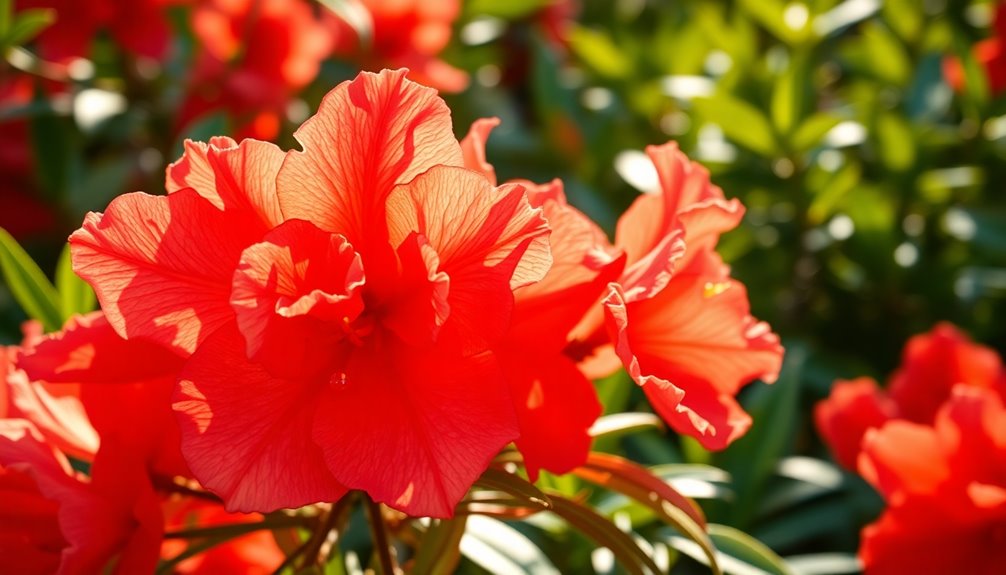
As you plan your garden, consider the Autumn Ember Azalea, a stunning addition that offers vibrant orange-red blooms and striking fall foliage.
This compact shrub grows 3 to 4 feet tall and wide, thriving in full to partial sunlight for at least four hours daily. It flourishes in well-draining, acidic soil, so ensure you dig a hole large enough for its root ball when planting. Additionally, this azalea is part of the popular Encore Azalea series, which is known for its continuous blooming cycle.
Afterward, mulch around the base to retain moisture. You'll love its slight fragrance and the way it attracts bees and butterflies.
This azalea reblooms in spring and late summer, providing color throughout the seasons. Just remember to fertilize in spring and prune lightly for bushier growth.
Enjoy this beauty in your garden!
Frequently Asked Questions
How Often Should I Water These Plants?
You should water your plants based on their specific needs. Most plants thrive with about one inch of water per week.
Adjust your schedule according to factors like soil type, climate, and whether they're in pots or the ground. For new plantings, give them a deep watering weekly.
Check the soil moisture regularly; if it's dry, it's time to water. Remember, overwatering can harm your plants, so find the right balance.
What Pests Are Common for These Plants?
If you think your garden's a peaceful oasis, you might be in for a surprise! Common pests like aphids and cucumber beetles can wreak havoc on your plants.
You'll notice stunted growth and holes in leaves. Keep an eye out for lace bugs and squash bugs too, as they might leave mottled spots and yellowing foliage.
Regularly check your plants and use natural predators or insecticidal soap to keep these intruders at bay!
Can These Plants Survive Winter Conditions?
Yes, many of these plants can survive winter conditions.
Hardy perennials like coneflower and catmint thrive in cold weather, returning each spring with proper care.
Evergreens such as blue spruce and arborvitae withstand harsh winters, maintaining their beauty.
Winter flowers like pansies and evening primrose can endure low temperatures, while winter shrubs like winterberry holly attract birds with their vibrant berries.
With the right selection, your garden can flourish even in winter.
Do These Plants Attract Pollinators?
Yes, these plants definitely attract pollinators! When you choose bright, vibrant colors like red, yellow, or purple, you'll draw in hummingbirds and butterflies.
Fragrant flowers, like lavender, will entice bees and moths. By ensuring your garden has nectar-rich blooms and continuous blooming throughout the seasons, you'll provide a steady food source.
Don't forget to include native species, as they often cater to local pollinators, enhancing your garden's appeal even more.
How Do I Propagate These Plants Successfully?
To propagate plants successfully, you can use several techniques.
Start with cuttings: take a healthy stem or leaf, remove lower leaves, and place it in water or soil.
Layering is another method; bend a branch to the ground, cover it with soil, and let roots form before separating.
For faster results, consider tissue culture or hydroponics if you have the resources.
Always ensure your growing medium is well-draining and sterilized for the best outcome.
Conclusion
By incorporating these 10 gorgeous plants into your garden, you'll not only enhance its beauty but also create a vibrant ecosystem. Did you know that gardens with diverse plant species can attract up to 50% more pollinators? This means that adding these stunning plants doesn't just benefit you; it supports local wildlife too. So, go ahead and transform your garden into a colorful haven that's both visually appealing and ecologically friendly. Your garden deserves it!
